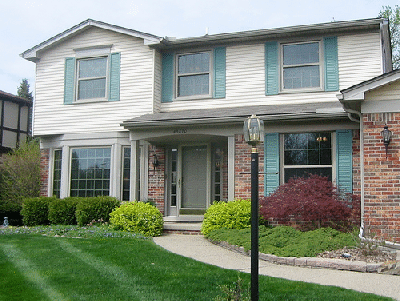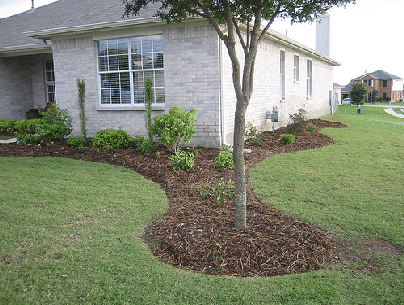Foundation Planting Ideas
Any Plant Can be Used for a Foundation Planting
Your foundation planting can be whatever you want it to be, but do first consider the function of a foundation planting. Add a small sitting area if you like, or include a fragrant herb garden. Use interesting texture or showy blooms. If you prefer a formal look, start with a pruned boxwood or evergreen hedge, and add less formal plants in front to transition to more casual areas of your landscape.
This foundation planting is fairly typical in the Midwest. Evergreen shrubs hide and insulate the foundation at left. In more sheltered areas like the corner of the home and garage, deciduous shrubs may be used. The front entry is accented by identical shrubs with bright foliage. A large shrub is used at the corner, but placed around the corner toward the side of the house, so as not to overwhelm the bay window area. The medium sized colorful shrub nicely balances the three evergreens on the other side, but should not be allowed to block any more of the window. A ground cover through the front of the beds unify the design. A cranberry painted door the same color as the shrub would add more focus to the entry area.
When your foundation planting does not need to cover a concrete foundation or add insulation, plantings do not need to be dense. Note that this newly planting foundation bed seams to leave plenty of room for plants to mature. However, some of these shrubs will mature well over four times the size they are now. They are too close to the structure to allow good air circulation and passing space. Pruning will be required in the near future. The tree has been planted a good distance from the corner, and included in the foundation bed by sweeping a curving island out to it. The tall narrow shrubs frame and accent the window without overpowering it.
A typical development planting is very minimal and uninteresting. Four identical shrubs add visual weight to the already weighty brick section of the home. Further adding to the out of balance design is a young tree planted too close to the structure. It will someday be too tall to be in front of a single story home, and should have been placed well off to the left of the entry, to prevent the abyss of nothingness on that side. Move the tree quickly while it is young enough to manage and will recover from the transplant.
This is such a lovely foundation planting, interesting and well balanced. Beginning first with a somewhat formal home design, a few formal elements are introduced into the foundation planting with well pruned evergreen shrubs, placed symmetrically at the entrance. This also maintains a very open and inviting entry space, and draws attention to the front door. Additional shrubs are less pruned and not symmetrical, adding color and texture, creating a perfect transition to casual gardens. The strong horizontal lines of the home’s design is repeated and reinforced by keeping the foundation planting low and continuous in another strong horizontal line. The vertical pillars and tall narrow windows prevent the horizontal lines from overpowering, without interrupting, the horizontal architecture like strong vertical evergreens would.
There is a pretty good chance the owners of this house for sale just completed the foundation planting to show the house. It actually looks fairly well designed right now, but it won’t last. The small globe shrubs cover the concrete foundation of the entry steps, but in only a couple of years will overgrow the steps. It is difficult to see, but there are also small plants literally right up against the foundation. They will all have to be removed soon. The two small trees are young with an open crown right now, but will soon completely hide the house. It is an adorable house and planting design, but move all the plants quickly before they are well rooted.
A lovely, somewhat formal, arrangement of shrubs and annuals does not quite hit the mark. It looks out of scale with the size of the home. It can be simply corrected by adding a little visual weight to balance with the structure, and add vertical interest. A larger shrub could replace the two small arborvitae to the right of the window. Then add a tall conical just to the right of the corner past the window.
The foundation planting of this beautiful home does absolutely nothing to enhance the structure. A straight line of tiny identical shrubs creates no interest and is completely out of scale with the size of the house. Don’t be tempted to just expose your beautiful home. Enhance it!
This is difficult. The rhododendrons are drop dead gorgeous. But when they are out of bloom do they do anything to enhance the home? As difficult as it would be to remove these beauties, the year round interest of a decorative foundation planting should at least be considered. Perhaps if one plant at the entrance step was kept, and try to find a place elsewhere for the others. Unfortunately there does not appear to be much space on the other side to flank the stairs. The home itself is so lovely it does not need much enhancement, just a transition anchor. Start by adding small evergreen shrubs on both sides of the home to provide a little balance.
A foundation planting at the side or rear of the home can be much more casual. This perennial planting is wonderful.
A casual or country home design is appropriate for casual or cottage plantings at the foundation. Especially at the corners of the home to transition to side and rear gardens, you can even include a kitchen garden or fragrant herbs.
A foundation planting at the side or rear of your home is a perfect place to include small shrubs, perennials or annuals, and texture. This mixed border is an interesting composition with a weeping hemlock, hosta and blooming shrubs for year round interest.










